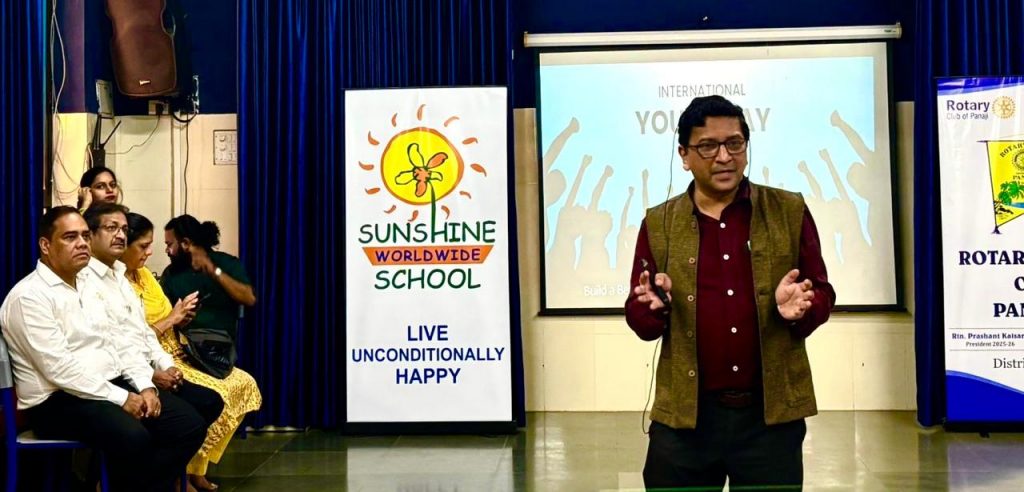Goa is abuzz with excitement as vintage bike and car owners, users, collectors and fans are decking […]

RISING ABOVE PRESSURE: TEACHING TEENS TO THRIVE, NOT JUST SURVIVE! By Dr Amit Dias, MD
Aug 30-Sept 05, 2025, MIND & BODY, HEART & SOUL August 29, 2025Speaking to the students of Sunshine School as part of International Youth Day, Dr Amit Dias addressed a pressing concern — the rising mental health challenges among adolescents. This article emphasizes the vital need to build resilience early, equipping young minds with the skills to navigate stress, setbacks, and the pressures of growing up. This unique interactive session was organised by the Rotary Club of Panjim.
“The greatest glory in living lies not in never falling, but in rising every time we fall.” – Nelson Mandela
Parents and teachers celebrate not just academic milestones but also the growth of young minds into responsible adults. Yet, behind the bright smiles of many adolescents lie silent struggles. Across the world, and increasingly in India, suicide has become one of the leading causes of death among adolescents. According to the World Health Organization, nearly one in seven adolescents (10–19 years old) live with a mental health condition, and suicide ranks as the fourth leading cause of death in this age group.
Why adolescence is a crucial period
ADOLESCENCE is often called the “in-between” stage – not quite a child, not yet an adult. It is a period of rapid brain development, particularly in the areas that control decision-making and impulse regulation. It’s a stage where they gain maturity. At the same time, hormonal changes heighten emotions, making teenagers more prone to impulsiveness.
Add to this the intense pressure to perform academically, look a certain way, or be accepted socially, and the result is often overwhelming.
Children may feel trapped between expectations and reality. A student who fails to score high marks might feel like a failure in life. Teenagers constantly comparing themselves to “perfect” bodies on social media may develop unhealthy self-image issues. Some children internalize these struggles quietly, while others act out. Sadly, a few may see no way out except by harming themselves.
What is resilience?
RESILIENCE is not about avoiding stress or pain — it is about learning how to cope, adapt and bounce back in the face of challenges. A resilient child understands that failure is not the end, but an opportunity to grow. They are able to face rejection, disappointment, or criticism without losing their sense of self-worth.
Think of resilience as a “mental immunity system” – just as we build physical immunity through good food and exercise, resilience builds emotional immunity through coping skills and support.


How can parents and teachers help build resilience?
•Create a safe space to talk: Encourage open conversations without judgment. Children should feel heard, not dismissed.
•Normalize failure: Share stories of famous personalities who overcame failure. Remind children that setbacks are stepping stones.
•Model healthy coping: Children learn more from what adults do than what they say. Show them how you manage stress positively.
•Encourage problem-solving: Instead of fixing every issue, guide children to think of solutions themselves.
•Balance academics and life skills: Success is not only marks — it’s teamwork, creativity, kindness, and perseverance.
Signs to be aware of Parents and teachers should stay alert to changes such as:
•Withdrawal from friends and activities once enjoyed
•Sudden changes in eating or sleeping patterns
•Expressions of hopelessness (“What’s the point?”)
•Drop in academic performance
•Risky or self-harming behavior
Recognizing these early can save lives.
Practical ways to build resilience in children
•Encourage sports, music, art, and hobbies – outlets that reduce stress.
•Teach mindfulness and relaxation techniques such as deep breathing.
•Build a supportive peer environment – discourage bullying and promote kindness.
•Teach children to set realistic goals and celebrate small achievements.
A collective responsibility
BUILDING resilience is not a task for parents or teachers alone—it requires a community. Schools can incorporate life-skills training, governments can invest in mental health programs, and society can reduce the stigma around seeking help.
Let us ensure that no child feels alone in their struggles. With love, patience, and the right guidance, we can raise a generation that not only survives challenges but thrives in spite of them.
(Dr Amit Dias is an assistant professor in the Department of Preventive & Social Medicine at Goa Medical College & Hospital. He has extensive experience in the field of mental health and has worked for several years on initiatives aimed at promoting emotional well-being. Dr Dias has also written widely on strategies to improve mental health and build resilience, particularly among children and adolescents.)















